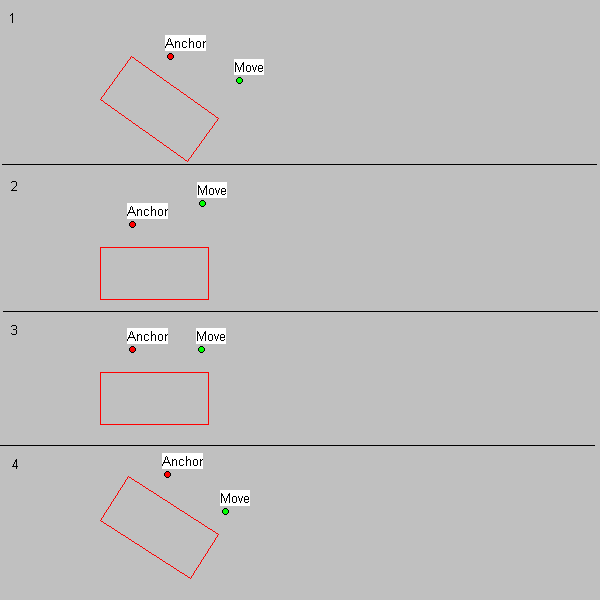|
|
Available in LEADTOOLS Document and Medical Imaging toolkits. |
#include "l_bitmap.h"
L_LTANN_API L_INT L_AnnAdjustPoint(pptAnchor, pptMove, dAngle, nType)
|
pANNPOINT pptAnchor; |
/* pointer to an ANNPOINT structure that contains the anchor point */ |
|
pANNPOINT pptMove; |
/* pointer to an ANNPOINT structure that contains the point to be adjusted */ |
|
L_DOUBLE dAngle; |
/* angle of rotation */ |
|
L_INT nType; |
/* type of adjustment to point */ |
Modifies the point pptMove based on the angle from line (pptAnchor, pptMove) and the horizontal.
|
Parameter |
Description |
|
|
pptAnchor |
Pointer to an ANNPOINT structure representing the anchor point. |
|
|
pptMove |
Pointer to an ANNPOINT structure representing the point to be adjusted |
|
|
dAngle |
Angle of rotation in radians. Ranges from -Pi to Pi, (-3.1415 - 3.1415) where a positive angle corresponds to clockwise rotation. |
|
|
nType |
Type of adjustment to point. Possible values are: |
|
|
|
ANNADJUST_HORIZONTAL |
[1] |
|
|
ANNADJUST_VERITCAL |
[2] |
|
|
ANNADJUST_45_DEGREES_FAVOR_X |
[3] |
|
|
ANNADJUST_45_DEGREES_FAVOR_Y |
[4] |
Returns
|
SUCCESS |
The function was successful. |
|
< 1 |
An error occurred. Refer to Return Codes. |
Comments
This utility function is used when creating custom annotation objects. It can be used to calculate the horizontal, vertical, or 45 degree component of a rotated annotation object. It can also be used to easily restrict the mouse cursor on rotated annotation objects.
As an example, consider a rectangle that is rotated 35 degrees in the clockwise direction.

The user has clicked on the Anchor point, and moved the mouse to the Move point.
To find the horizontal component of the line that goes from (Anchor, Move), make the following call, and the ptMove point is adjusted to contain only the horizontal component.
The adjusted ptMove can be seen in step 4.
L_AnnAdjustPoint(&ptAnchor, &ptMove, 35*PI/180, ANNADJUST_HORIZONTAL)
Conceptually, the following occurs:
|
1. |
Initial situation |
|
2. |
Points and rectangle are rotated 35 degrees counter clockwise |
|
3. |
Move point is adjusted to contain only the horizontal component |
|
4. |
Points and rectangle are rotated 35 degrees clockwise to give adjusted Move point. |
Required DLLs and Libraries
|
LTANN For a listing of the exact DLLs and Libraries needed, based on the toolkit version, refer to Files To Be Included With Your Application. |
Win32, x64.
See Also
Example
This is part of the custom annotations demo (from example1.c). This handler gets called when there is a mouse move message on a user handle. There are four user handles that are processed differently. The HANDLE_ID_VERTICAL_LEFT and HANDLE_ID_VERTICAL_RIGHT handles restrict the mouse cursor to a line parallel to the top of the rectangle, even if the rectangle is rotated. The HANDLE_ID_HORIZONTAL_BOTTOM handle restricts the mouse cursor to a line parallel to the side of the rectangle, even if the rectangle is rotated. The HANDLE_ID_HORIZONTAL_TOP handle rotates the rectangle around the bottom handle (HANDLE_ID_HORIZONTAL_BOTTOM).
/*<struct>*/
#if !defined (LET_DEFINE)
typedef struct _ANNCHILDDATA
{
HANNOBJECT hObjectChange;
POINT pt0;
POINT pt;
L_INT nUserHandleID;
HANNOBJECT AnnObjectNeighbors[2];
}ANNCHILDDATA, *LPANNCHILDDATA;
#endif
/*</struct>*/
L_INT AnnAdjustPointExample(LPANNCHILDDATA pData, pANNMOUSEPOS pMousePos)
{
L_INT nRet;
L_DOUBLE dAngle;
ANNPOINT ptAnchor, ptMove;
nRet = L_AnnGetRotateAngle(pData->hObjectChange, &dAngle);
if(nRet != SUCCESS)
return nRet;
ptAnchor.x = pData->pt0.x;
ptAnchor.y = pData->pt0.y;
ptMove.x = pMousePos->pt.x;
ptMove.y = pMousePos->pt.y;
switch (pData->nUserHandleID)
{
case HANDLE_ID_VERTICAL_LEFT:
case HANDLE_ID_VERTICAL_RIGHT:
{
L_DOUBLE dx, dy;
POINT pt;
nRet = L_AnnAdjustPoint(&ptAnchor, &ptMove, dAngle, ANNADJUST_HORIZONTAL);
if(nRet != SUCCESS)
return nRet;
dx = (ptMove.x - ptAnchor.x)/2;
dy = (ptMove.y - ptAnchor.y)/2;
pt = pMousePos->pt;
pt.x = (LONG)(ptAnchor.x + dx);
pt.y = (LONG)(ptAnchor.y + dy);
nRet = L_AnnDefine(pData->hObjectChange, &pMousePos->pt, ANNDEFINE_APPEND);
if(nRet != SUCCESS)
return nRet;
nRet = L_AnnDefine(pData->AnnObjectNeighbors[1], &pt, ANNDEFINE_APPEND);
if(nRet != SUCCESS)
return nRet;
}
break;
case HANDLE_ID_HORIZONTAL_BOTTOM:
nRet = L_AnnAdjustPoint(&ptAnchor, &ptMove, dAngle, ANNADJUST_VERTICAL);
if(nRet != SUCCESS)
return nRet;
nRet = L_AnnDefine(pData->hObjectChange, &pMousePos->pt, ANNDEFINE_APPEND);
if(nRet != SUCCESS)
return nRet;
nRet = L_AnnDefine(pData->AnnObjectNeighbors[1], &pMousePos->pt, ANNDEFINE_APPEND);
if(nRet != SUCCESS)
return nRet;
break;
case HANDLE_ID_HORIZONTAL_TOP:
nRet = L_AnnDefine(pData->hObjectChange, &pMousePos->pt, ANNDEFINE_APPEND);
if(nRet != SUCCESS)
return nRet;
nRet = L_AnnDefine(pData->AnnObjectNeighbors[1], &pMousePos->pt, ANNDEFINE_APPEND);
if(nRet != SUCCESS)
return nRet;
break;
default:
break;
}
pMousePos->fUpdatePos = FALSE;
if (
(pData->nUserHandleID == HANDLE_ID_VERTICAL_LEFT) ||
(pData->nUserHandleID == HANDLE_ID_VERTICAL_RIGHT) ||
(pData->nUserHandleID == HANDLE_ID_HORIZONTAL_TOP) ||
(pData->nUserHandleID == HANDLE_ID_HORIZONTAL_BOTTOM)
)
{
if (ISDIFFERENT(&ptMove,&pMousePos->pt))
{
pMousePos->pt.x = ROUND(ptMove.x);
pMousePos->pt.y = ROUND(ptMove.y);
pMousePos->fUpdatePos = TRUE;
}
}
return SUCCESS;
}